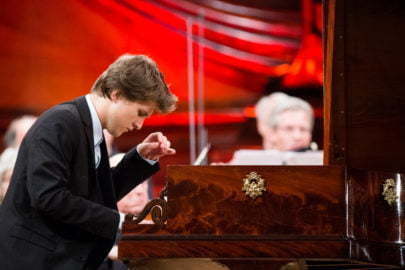The 1st International Chopin Competition on Period Instruments is a triumph in Warsaw
When it comes to the making of pianistic history, no venue worldwide has witnessed more than Warsaw’s Philharmonic Hall. The annals of the Chopin Competition read like a Who’s Who of pianism and have featured more big-name prize-winners – including Maurizio Pollini, Martha Argerich and Krystian Zimerman – than any other musical contest.
But the Chopin Competition is not resting on its laurels, or even laureates, and with the launch this month of the 1st International Chopin Competition on Period Instruments it has again produced Chopin playing of the highest order.

Award gala and concert after First International Chopin Piano Competition on period instruments. 14th September 2018, Warsaw, Poland
photo by Wojciech Grzedzinski/NIFC
This new event was hotly contested by 30 players from nine countries. The eventual winner was Poland’s Tomasz Ritter, second prize was shared between Naruhiko Kawaguchi (Japan) and Aleksandra Świgut (Poland), and third prize went to Krzysztof Książek, also of Poland.
The rules here required contestants to play some Bach in the first round, plus polonaises by Chopin’s Polish predecessors. Participants were also able to choose from a range of instruments of the sort Chopin would have known, not only Erards and Pleyels but pianos by the makers Buchholtz, Graf and Broadwood. This made the jury’s work tougher: unlike homogenised modern instruments, piano design in the 19th century was still evolving, and the instruments had far more individuality.
(via the Guardian)
5 piano models ( 3 original pianos and 2 copies by Paul McNulty – Buholtz and Pleyel) on stage ready for the First International Chopin Competition on Period Instruments! pic.twitter.com/XKRxs1NHo6
— Viviana Sofronitsky (@VSofronitsky) September 17, 2018
Theater und Orchester mit sinkenden Besucherzahlen
Der Deutschen Bühnenverein, die Arbeitgebervereinigung der deutschen Theater und Orchester, hat die Theaterstatistik für die Saison 2016/17 veröffentlicht. In ihre sind die wichtigsten Wirtschaftsdaten der Theater und Orchester in Deutschland dokumentiert. Für die Statistik hatten rund 140 Staatstheater, Stadttheater und Landesbühnen, 128 Orchester, 210 Privattheater und 84 Festivals ihre Daten geteilt.
Bei öffentlich getragenen Organisationen stiegen die Zuschüsse um hundert Millionen Euro auf etwa 2,6 Milliarden Euro, was eine Erhöhung um 3,7 Prozent darstellt. Die Zahl der Vorstellungen ist dagegen von 67.257 auf insgesamt 65.794 Veranstaltungen zurückgegangen. Dies stellt einen Rückgang um 2,2 Prozent dar. Die Eigeneinnahmen der Orchester und Theater blieben dennoch mit rund 551 Millionen Euro stabil.
Die Besucherzahlen sind im betrachteten Zeitraum von 21 Millionen Interessierten um rund 500.000 auf 20,5 Millionen Zuschauer gesunken.
Mehr Geld durch Zuschüsse, das für mehr Vorstellungen und MitarbeiterInnen ausgegeben werden kann. Läuft bei den deutschen #Theatern und #Orchestern 😉 Das sagt zumindest die neue Statistik des @buehnenverein: https://t.co/yl4dGY5X9q
— KulturManagementNet (@kmnweimar) September 19, 2018
The German Stage Association has published the theatre statistics for the 2016/17 season. About 140 state, city and national theatres, 128 orchestras, 210 private theatres and 84 festivals shared their data.
For publicly funded organisations, grants increased by one hundred million euros to some € 2.6 billion, an increase of 3.7 percent. By contrast, the number of performances has fallen from 67,257 to a total of 65,794 events. This represents a decline of 2.2 percent. However, the individual revenues of the orchestras and theatres remained stable at around 551 million euros. The number of visitors had also fallen by about 500,000 to 20.5 million viewers.
(via Klassik)
 BACK
BACK